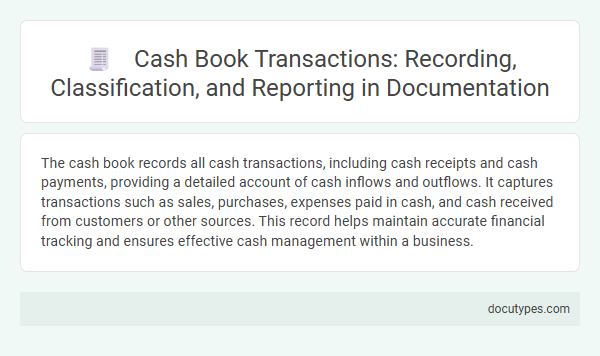The cash book records all cash transactions, including cash receipts and cash payments, providing a detailed account of cash inflows and outflows. It captures transactions such as sales, purchases, expenses paid in cash, and cash received from customers or other sources. This record helps maintain accurate financial tracking and ensures effective cash management within a business.
Introduction to Cash Book Transactions
The cash book is a primary accounting record that captures all cash-related transactions. It serves as both a journal and a ledger for cash receipts and payments.
Transactions recorded in the cash book include cash sales, cash purchases, cash receipts from customers, and cash payments to suppliers. It also tracks bank deposits and withdrawals to maintain accurate cash flow records.
Importance of Accurate Cash Book Documentation
The cash book records all cash transactions, including cash receipts and cash payments. It serves as both a journal and a ledger for cash-related activities.
Accurate cash book documentation ensures transparency and helps prevent errors in financial reporting. It provides a reliable audit trail vital for financial control and decision-making.
Types of Cash Books Used in Reporting
| Type of Cash Book | Description | Transactions Recorded | Purpose in Reporting |
|---|---|---|---|
| Single Column Cash Book | Records only cash transactions in one column on each side. | All cash receipts and cash payments. | Tracks daily cash inflows and outflows for cash management and financial reporting. |
| Double Column Cash Book | Maintains two columns on both debit and credit sides, typically cash and bank columns. | Cash transactions and bank-related transactions like deposits and withdrawals. | Provides detailed recording of cash and bank transactions to reconcile bank balances and cash positions. |
| Triple Column Cash Book | Features three columns on both debit and credit sides covering cash, bank, and discount. | Cash receipts/payments, bank deposits/withdrawals, and discount allowed/received. | Combines cash, bank, and discount tracking improving accuracy in financial reporting and facilitating discount analysis. |
| Petty Cash Book | Used for recording minor cash expenses handled through the imprest system. | Small day-to-day expenses like stationery, postage, or tea expenses. | Monitors small payments ensuring accountability and control over petty cash disbursements in reports. |
Recording Cash Receipts and Payments
The cash book records all cash transactions, including cash receipts and cash payments. Cash receipts include money received from sales, loans, and other income sources. Cash payments cover expenditures such as payments to suppliers, expenses, and loan repayments recorded systematically in the cash book.
Classification of Cash Book Entries
What types of transactions are recorded in the cash book? The cash book captures all cash receipts and payments, reflecting daily financial activities. Your entries are classified into cash inflows and cash outflows for accurate tracking.
How are cash book entries classified? Transactions are categorized as either cash or bank entries, depending on whether they involve physical currency or bank deposits. This classification helps in maintaining a balanced and clear record.
Procedures for Balancing the Cash Book
The cash book records all cash transactions, including cash receipts and cash payments. It serves as both a journal and a ledger for cash-related entries.
- Cash Receipts - Records all money received by the business to track inflows accurately.
- Cash Payments - Documents all money paid out by the business for expenses and purchases.
- Balancing Procedures - Involves totaling debit and credit columns and determining the cash balance to ensure accuracy.
You must perform regular balancing of the cash book to maintain precise financial records and prevent discrepancies.
Common Errors in Cash Book Documentation
The cash book records all cash transactions including cash receipts and cash payments. Common errors in cash book documentation involve omissions, posting inaccuracies, and incorrect date entries. These mistakes can lead to discrepancies in financial statements and affect accurate cash flow management.
Internal Controls for Cash Book Transactions
The cash book records all cash-related transactions within a company, including receipts and payments. It acts as both a journal and ledger, ensuring accurate tracking of cash inflows and outflows.
Transactions recorded in the cash book typically include cash sales, cash purchases, petty cash expenses, bank deposits, and withdrawals. Internal controls for these transactions involve segregation of duties, regular reconciliations, and authorization protocols to prevent errors and fraud. Your responsibility includes maintaining accurate entries and safeguarding cash to uphold financial integrity.
Cash Book Reporting and Financial Statements
The cash book records all cash and bank transactions, serving as a primary accounting document for tracking liquidity. It reflects real-time cash flow details crucial for accurate financial reporting and statement preparation.
The cash book integrates cash receipts and payments, ensuring comprehensive recording of monetary exchanges for the business period. These records directly influence the accuracy of financial statements such as the balance sheet and cash flow statement.
- Cash Receipts - Include all incoming cash transactions such as sales revenue, loans received, and capital deposits.
- Cash Payments - Encompass all outgoing cash transactions including expenses, purchases, and loan repayments.
- Bank Transactions - Record deposits, withdrawals, and transfers between cash and bank accounts affecting overall cash position.
What Types of Transactions Are Recorded in the Cash Book? Infographic

